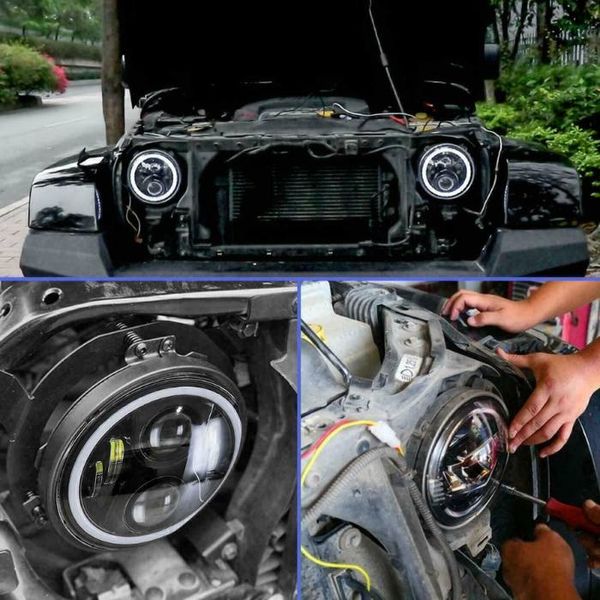Headlights are crucial for safe driving, but with so many options on the market, it can be challenging to determine which type is best for your vehicle. The halo headlights, with their distinctive circular light pattern, have captured the attention of drivers worldwide. In this blog post, we will dive into the world of halo headlights, revealing their key performance factors, customization options, and legal considerations. By the end, you will be well-equipped to make an informed decision on whether “are halo headlights better” for your car or not.
Key Takeaways
- Halo headlights offer improved visibility and a unique aesthetic for vehicles.
- LED halo headlights provide superior illumination, energy efficiency, and longevity compared to halogen headlights.
Understanding Halo Headlights
Halo headlights, also known as angel eyes or demon eyes, have become increasingly popular due to their unique design and enhanced visibility. These headlights differ from traditional headlights by using light-emitting diodes (LEDs) to generate a concentrated beam of light, illuminating more road surfaces at farther distances than customary reflector headlights.
We’ll now delve into the intricacies of how halo headlights function and their distinctive features.
What are Halo Headlights?
Halo headlights, commonly referred to as halo lights, halos, corona rings, or angel eyes, are a distinctive arrangement of lights placed in a circular pattern around the headlights of a vehicle. They are often employed as running lights, turn signals, or to add an aesthetically pleasing element to the headlight construction. Conventional halo rings are a popular choice for car enthusiasts looking to enhance their vehicle’s appearance.
With their attention-grabbing appearance, halo headlights not only enhance the visual appeal of a car, but also improve visibility on the road.
How Halo Headlights Work
The technology behind halo headlights involves:
- LED diodes that illuminate the halos
- Extra-bright LED-specific projectors for the headlight itself
- Specially designed reflector, shutter, and lens that concentrate the light into a precisely managed beam, facilitating organized light distribution.
Halo headlights can be used with various bulb types, including halogen, LED, HID, and laser bulbs, making them a versatile option for many vehicles.
Comparing Headlight Types: Halogen, LED, HID, and Laser

When it comes to headlight options, there are four primary types:
- Halogen
- LED
- HID
- Laser
Each type has its advantages and disadvantages, depending on factors such as performance, energy efficiency, lifespan, and cost.
A detailed comparison of these headlight types, to guide you in choosing the most suitable option for your drive, will follow.
Halogen Headlights
Halogen headlights, which can be utilized in projector headlights designs, offer a more even light beam compared to reflectors. However, they emit a warmer light that does not provide wide-reaching illumination outside the windshield, potentially impeding visibility and creating hazards when driving in dimly lit environments. The key advantage of halogen headlights is their affordability and ease of replacement, making them a popular choice among vehicle owners.
In terms of technology, halogen headlights:
- Employ halogen gas within the bulb instead of argon gas, which is present in traditional incandescent bulbs. This is what differentiates them from halogen lights.
- Last longer and brighter
- Produce a warm and yellow color temperature
Despite their low cost and simplicity, halogen headlights are less bright and energy efficient than alternatives like LED or HID headlights.
LED Headlights
LED headlights, also known as light emitting diode headlights, utilize two semiconductors on a chip that houses electrons. When electricity is applied to this arrangement, the atoms move toward each other, producing a highly luminous light. They require minimal power to operate, making them more energy efficient than halogen headlights. LED headlights offer a level of brightness and coverage comparable to that of HIDs and superior to that of halogens.
The primary advantages of LED headlights are energy efficiency and a high level of illumination. They are also more robust and can withstand various conditions encountered on the road. However, LED headlights may not be suitable for all applications, and their initial cost is higher than that of halogen headlights. Despite the higher upfront cost, their longer lifespan and energy savings make them a popular choice for many drivers.
HID Headlights
HID headlights provide a significant advantage in terms of improved visibility, as they produce more than 3,000 lumens and 90 mcd/m2 through a typical 35w ballast, which is greater than twice the lumens and mcd/m2 generated by a halogen bulb. However, HID headlights may lead to potential glare and are not available for all vehicle models, unlike the more versatile led bulb.
Some drivers prefer HID headlights over halogen or LED headlights due to their increased brightness and range. However, it is essential to consider the potential drawbacks, such as the risk of blinding oncoming traffic due to glare. When choosing between HID and halogen headlights, it is crucial to weigh the benefits and drawbacks in terms of performance and safety.
Laser Headlights

Laser headlights are a cutting-edge technology in automotive lighting, utilizing laser diodes to produce a highly intense and focused beam of light. They are more energy efficient and provide better visibility in comparison to traditional halogen, xenon, and LED headlights, offering improved brightness and range. Consequently, laser headlights are a promising advancement in automotive lighting technology.
Despite their advantages, laser headlights are costly and not yet sanctioned in certain areas. Before installing laser headlights, it is essential to assess local legislation and consider professional installation to ensure proper functioning and safe operation.
As laser headlights become more widely available and legal restrictions ease, they may become a popular headlight option in the future.
Halo Headlights Performance Factors
Assessing the performance of halo headlights requires attention to factors like:
- Brightness
- Visibility
- Beam pattern
- Range
- Lifespan
- Durability
These factors are influenced by the type of light bulbs employed, the wattage of the bulb, and the reflector design.
As we progress, we will further examine these performance factors to equip you with the knowledge to make an informed decision about halo headlights.
Brightness and Visibility
Brightness is a critical factor in halo headlights, as it directly impacts visibility and safety on the road. Halo headlights typically utilize ultra-bright LEDs, emitting a white light that is more visible than the yellowish light of halogen bulbs.
For optimal night vision, it is recommended that a low beam headlight have between 3200 and 3600 lumens. By choosing halo headlights with the appropriate brightness, you can ensure better visibility and safer driving conditions.
Beam Pattern and Range
Beam patterns play a significant role in visibility and safety while driving. Halo headlights generally offer a wider and more dispersed beam pattern, allowing for improved peripheral visibility. However, they may not provide the same range as LED, HID, or laser headlights.
It is crucial to consider the beam pattern and range of halo headlights when assessing their performance to ensure they meet your specific driving needs.
Lifespan and Durability
The expected lifespan of halo headlights varies and may be affected by factors such as usage and environmental conditions. LED lights. Halo headlights have a considerably longer lifespan compared to halogen headlights, with an estimated duration of 12 years.
By choosing halo headlights with a longer lifespan, you can save on replacement costs and enjoy enhanced performance for an extended period.
Customization Options for Halo Headlights

Halo headlights offer various customization options, allowing drivers to personalize their vehicle’s appearance and enhance functionality. Some popular customization options include RGB halo headlights, amber switchback halo headlights, and rotating RGB halo headlights.
RGB Halo Headlights
RGB halo headlights feature:
- Clear or tinted lenses
- Chrome-plated or black backgrounds
- One or two glowing halo rings
- RGB color functionality
- Optional fog lights
These headlights allow for individual LED control, enabling the creation of unique led light signatures and added personalization with the use of led lights.
With RGB halo headlights, you can customize your vehicle’s appearance with various colors and effects, making it stand out on the road.
Amber Switchback Halo Headlights
Amber switchback halo headlights feature a dual-color LED that can alternate between white and amber. This enables the headlights to be used as both daytime running lights and a turn signal, improving visibility and safety while driving.
With amber switchback halo headlights, you can enhance your vehicle’s functionality while maintaining its unique appearance.
Rotating RGB Halo Headlights
Rotating RGB halo headlights offer individual LED control within the halo, creating motion and visual effects. These headlights feature a rotating RGB halo ring, which can change colors and patterns, providing a dynamic lighting effect.
Rotating RGB halo headlights not only give your vehicle a unique and visually appealing aesthetic, but also allow for various lighting effects to suit your preferences.
Legal Considerations and Installation Tips

Before installing aftermarket halo headlights, it is crucial to consider the following:
- Legal aspects and DOT certification to ensure road legality
- Installation tips and techniques
- Deciding whether to install them independently or seek professional assistance
We will now turn our attention to the legal considerations and installation tips for halo headlights, aiding you further in making an informed decision.
Road Legality and DOT Certification
It is imperative to verify local laws and confirm DOT certification before installing aftermarket halo headlights. DOT certification guarantees that the headlights comply with safety regulations established by the Department of Transportation.
By ensuring your halo headlights are road legal and DOT certified, you can avoid potential fines and penalties while maintaining the safety of your vehicle.
DIY vs. Professional Installation
When it comes to installing halo headlights, you may choose to do it yourself or seek professional help. DIY installation can be more economical, but requires technical proficiency and carries the risk of damaging the headlights or the vehicle if not done correctly.
On the other hand, professional installation may be more costly but guarantees the task is accomplished correctly and safely. Ultimately, the choice between DIY and professional installation depends on your skill level, budget, and personal preferences.
Summary
In a nutshell, halo headlights offer a unique and visually appealing option for drivers seeking to enhance their vehicle’s appearance and performance. By understanding key performance factors, customization options, and legal considerations, you can make an informed decision on whether halo headlights are the right choice for you. With their distinctive design, improved visibility, and customization possibilities, halo headlights are undoubtedly a stylish and functional addition to any vehicle. Do You want to know more about the Best Halo Headlights? Check out our in depth review Here! We'll show you the top-performing brands.
Frequently Asked Questions
What is the point of Halo headlights?
Halo headlights provide a decorative glow around vehicle headlights, creating a unique look that BMW’s “angel eyes” pays homage to earlier models.
They can serve as daytime running lights and accent lighting, with sizes ranging from 60 mm-120 mm and LED count from 15-39.
Are halo lights better than LED?
LED lights are generally a better option than halogen lights, as they offer higher brightness levels with lower wattage and much longer lifespans, up to 25-50x longer compared to halogen bulbs.
They also use up to 80% less energy.
What are the four primary types of headlights?
The four primary types of headlights are halogen, LED, HID and laser, providing drivers with a range of options to best suit their needs.
Halogen headlights are the most common type of headlight and are the least expensive option. They are also the least efficient, as they require more energy to produce the same amount of light as other types of headlights.
LED headlights are LED lights.
What customization options are available for halo headlights?
Customizing halo headlights is a popular option, with available choices ranging from RGB, amber switchback, and rotating RGB.
What should I consider when choosing between DIY and professional installation of halo headlights?
When deciding between DIY and professional installation of halo headlights, consider your skill level, budget, and personal preferences.
DIY installation can be more economical, but requires technical proficiency, while professional installation guarantees a safe and correct outcome.
This post may contain affiliate links, which means Anchor Reviews may receive a commission if you purchase through my links, at no extra cost to you. It helps us to keep finding and writing about awesome products for you. Please read the full disclosure for more information.








